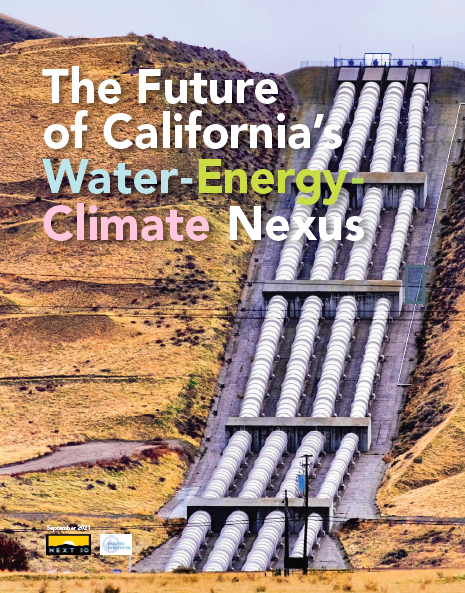The Future of California’s Water-Energy-Climate Nexus

The Future of California’s Water-Energy-Climate Nexus
Overview
Water and energy are inextricably linked in California and, as one resource faces constraints or challenges, so does the other. With the state looking to both reach its climate change goals and decarbonize its economy through a transition to 100% clean energy, water will play an integral role.
This report finds that without urgent water efficiency measures, carbon emissions associated with water usage in California are likely to spike in coming years, as changing sources of water supply and population growth drive up energy-intensive urban and agricultural water needs. The report identifies specific water policies that could play an important role in helping the state meet energy and greenhouse gas emissions goals.
The report was produced by Next 10, in collaboration with the Pacific Institute.
Key Findings
Urban water key findings include:
- If urban per capita water demand is maintained at current (2015) levels, statewide urban water demand would increase 24 percent (1.3 million acre-feet, or MAF) between 2015 and 2035 with population growth.
- If per-capita water demand increases to levels consistent with urban water suppliers’ projections (a “high case” scenario), urban water demand would increase by 44 percent (2.4 MAF) between 2015 and 2035, resulting in a 40 percent and 45 percent increase in related electricity and natural gas use, respectively.
- The authors found that more comprehensive water conservation and efficiency efforts in urban California could reduce water related electricity usage by 19 percent, natural gas use by 16 percent, and GHG emissions by 41 percent cumulatively between 2015 and 2035.
- While the total annual electricity use related to urban water use increases in the mid-case scenario, the average energy intensity of water the total electricity used per unit of water used decreases by two percent between 2015 and 2035.
Agricultural water key findings include:
- Central Valley agricultural water use under the mid-case scenario is projected to decline by two percent, or 0.3 MAF, between 2015 (23.4 MAF) and 2035 (23 MAF).
- There are also large uncertainties in the future energy use of Central Valley agriculture because of its dependence on groundwater, which the state has mandated through the Sustainable Groundwater Management Act (SGMA) to reach sustainable levels by 2040.
Cross-cutting key findings include:
- Overall, urban water efficiency improvements have the largest beneficial effect on California’s water-related energy use and GHG emissions because urban water is much more energy intensive than agricultural water.
- Water-related GHG emissions are driven by the pace of California’s electricity decarbonization and end use electrification.

